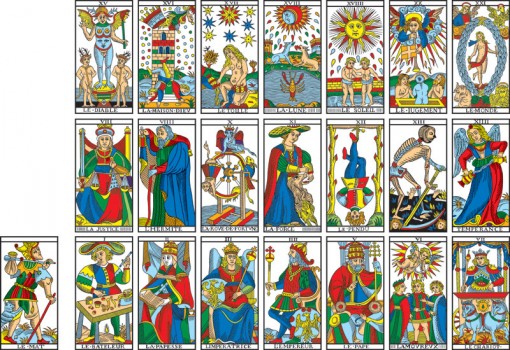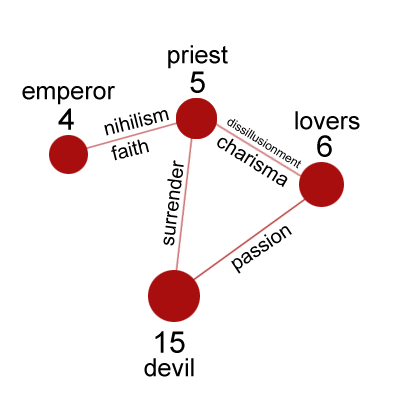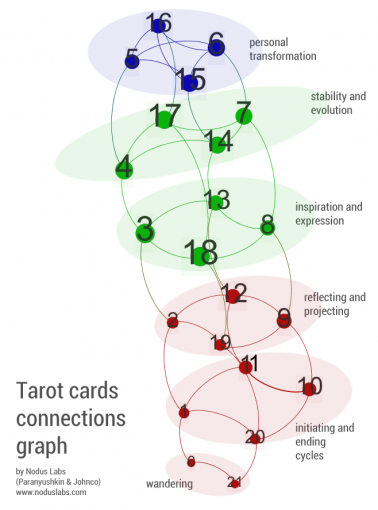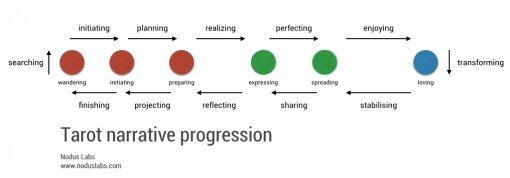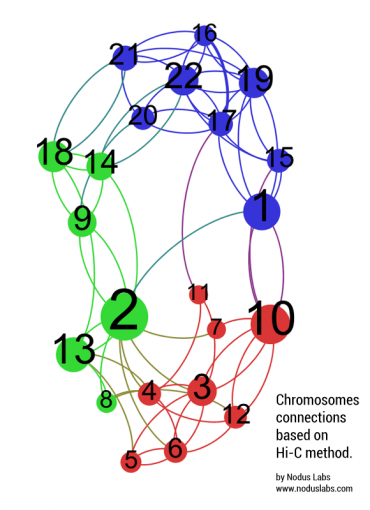Posted by Nodus Labs | October 24, 2014
The Divination Network of Tarot
Tarot is a deck of cards used since the 15th century to play various games as well as for divination purposes. We at Nodus Labs studied the structure of various Tarot decks, treating the cards as the nodes and relations between them as edges, building a graph of relations between the cards that are invariant across various Tarot decks. We discovered that the structure of the resulting graph has a very specific community structure, which makes Tarot a very efficient tool for telling narratives. We are currently working on practical implementations of this study.
This research was performed by Dmitry Paranyushkin and Colin Johnco.
Tarot as a Divination System
Tarot decks usually consist of 78 cards, of which 22 are the main cards, representing certain characters from the Tarot narrative. The main 22 character cards are each associated with a certain state. Different decks have different descriptions of those cards, but the main features of each card are usually consistent.
The way Tarot usually proceeds is that the one who reads asks the one whose Tarot is being read to pose a question. To find a response to this question, one should choose different cards from the shuffled deck and place them in a certain spread layout.
For example, one may ask “What can I expect from the future?”, pull 3 cards from the deck, and places them into a past-present-future layout, where one cards represents the Past (where one comes from), another card represents the Present (where one is right now), and the other card represents the Future (where one is heading).
There are different spreads in Tarot, but the most common ones use 3 or 4 cards at a time. What’s interesting is that Tarot is made in such a way that even pulling 3 or 4 cards from the deck can tell one a very extensive story using the characters (states) associated with cards.
In other words, Tarot is a very efficient mechanism of reading, which allows access to the whole story through randomly choosing only a few of its parts.
We were interested to study what are the features of Tarot as a system that make it such a powerful reading device.
Connections Between Tarot Cards
In order to study the structure of Tarot as a narrative tool, we needed to model it as a network. We represented the 22 main cards (from 0 to 21) as the nodes and their relations as the edges. We created several networks for different types of relations in order to be able to study them separately and to also compare information from different sources.
Traditionally there is a certain chronology to Tarot: the card number 5 (The Pope) is followed by the card number 6 (The Lovers) and preceded by the card number 4 (The Emperor). Based on this information we can build a directed graph 4 <-> 5 <-> 6 (Figure 2 below).
Moreover, usually in every deck every card has a certain interpretation and a set of keywords describing it. The relations between the cards also have descriptions, such as “In order to evolve the Emperor needs (to become) a Pope, and it is through faith that this step is made possible”. This yields a very data-rich graph structure for subsequent analysis.
There are also other types of connections between the cards. For example, a Mandala spread with the 22 main cards represents their evolution through the two cycles (1 to 10 and 11 to 20 with cards 0 and 21 being at the start/end of the both cycles). This spread takes into account the mirror connections that exist between the cards: e.g. 5 is closely related to 15, 6 is closely related to 16, etc.
Another important connectivity logic stems from a more numerological approach: as the highest number on the cards is the 21, then any two cards are connected if they add up to that “perfect” number, e.g. 6 + 15 = 21.
Figure 3 below shows this connectivity.
Using our network tool InfraNodus, we combined all the connectivity logics above into the separate graphs and analysed the relations between them.
The combined graph with meaning summaries for every card and connection was then used in the research. We used Textexture text network analysis tool to convert those summaries into a network to find the descriptions of the relations between the cards as well.
Those graphs can be seen as certain scanning tools enabling one to read Tarot narrative in a way that only a few steps along the graph would yield a comprehensive account of the whole narrative.
The Tarot Graph
The main property of the graph we obtained was its very specific community structure. Based on modularity algorithm we found 3 distinct communities – the cards that are more densely linked together than we with the rest of the network. Those communities are actually topics inside the Tarot narrative, which we separated into 5 groups indicated on the Figure 4 below. All those communities are also well linked together.
This kind of connectivity allows one to traverse the network in quite an efficient way: only a few steps along the paths between the cards are likely to go through most of the distinct communities (topics) present in the network. For example, a Tarot reading that starts from the card number 5 will need to take the previous (4) and the next cards into account (6), as well as the mirror card 15 and the 21 – 5 = card 16 to provide the most comprehensive advice. Such reading will form a graph similar to the one shown on Figure 3 above.
In other words, the way Tarot cards are connected forms an optimal structure for traversing through any other narrative that can be separated into 21 interrelated blocks.
Another interesting observation is that 4 cards have the highest betweenness centrality, which means they will appear more often than others when reading a Tarot narrative. Those cards are 3 (Empress), 18 (Moon), 4 (Emperor) and 17 (Star). Which means that if several Tarot readings are performed it is quite likely that those cards would come up as meaningful connections between different topics.
For example, if we follow traditional Tarot narrative, cards number 3 and 18 are often interpreted as a call to expression and inspiration (creativity), while the cards 4 and the cards 17 in combination refer to making a step from stability into the unknown, a search for the divine, which requires a strong foundation.
The resulting geometrical graph structure reminds a helix, which implies repetitive evolutionary movement. In this way, Tarot influences the content through its very structure. The way those cards are connected will always put them into relation with one another, bringing the one who reads through the same topics but from a different perspective.
Tarot, Chromosomes, and Narratives
Tarot is an efficient tool for navigating through interconnected clusters of information. However, there are many other existing systems that have also been optimized through evolutionary process to perform this task well.
For instance, in the works of Lieberman-Aiden he proposes a method for studying three-dimensional architecture of whole genomes and finding interactions between chromosomes. His studies confirm the presence of chromosome territories and the spatial proximity of small, gene-rich chromosomes. Moreover, the way chromosomes interact is consistent with a fractal globule, a knot-free, polymer conformation that enables maximally dense packing while preserving the ability to easily fold and unfold any genomic locus. In other words, chromosomes are connected in such a way, that taking the least space possible, they can maintain both their distinct nature, as well as their capacity to interact with each other. This kind of connectivity is reminiscent of the way Tarot cards are connected – a small, but efficient structure for linking distinct communities (topics) together.
Both networks have a similar community structure and similar graph metrics: distinct, but well-connected communities of nodes.
Connectivity maps of both Tarot and Chromosomes graphs show an efficient and optimized way for storing narratives. Structural properties of those graphs can then be used to apply similar principle to other types of content and create powerful narrative tools and narratives.

